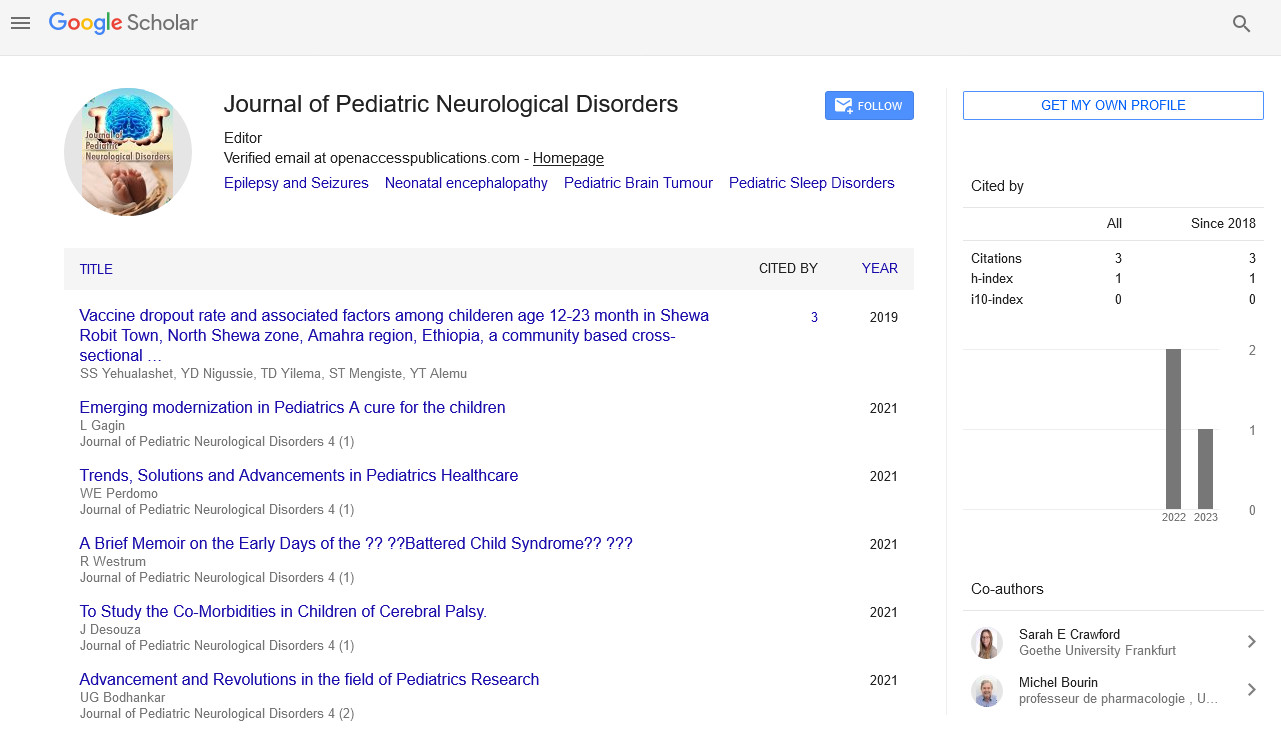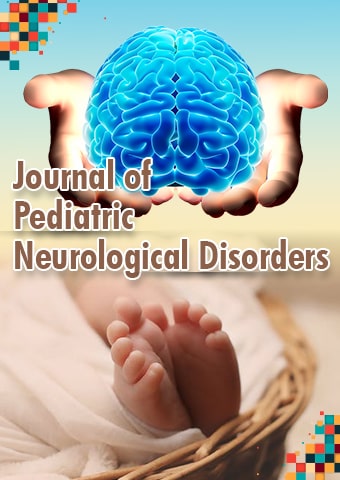Editorial - Journal of Pediatric Neurological Disorders (2023) Volume 6, Issue 2
Drug therapy for children with neuropsychiatric and epilepsy co-morbidities
Alex Moiré*
Department of Neurophysiology, Aix- Marseille University, France
Department of Neurophysiology, Aix- Marseille University, France
E-mail: moire@mar.ac.eu
Received: 01-Apr-2023, Manuscript No. pnn-23-97029; Editor assigned: 03-Apr-2023, PreQC No. pnn-23- 97029(PQ); Reviewed: 17-Apr-2023, QC No. pnn-23-97029; Revised: 20- Apr-2023, Manuscript No. pnn-23- 97029; Published: 27-Apr-2023, DOI: 10.37532/pnn.2023.6(2).21-23
Abstract
The fact that a wide range of comorbidities can be linked to epilepsy is becoming more and more accepted. Although epileptic seizures are an essential component of childhood epilepsy, a variety of neurological, mental health and cognitive disorders contribute to the disease burden, reducing quality of life. Depression, anxiety, autism spectrum disorders, sleep disorders, attention deficits, cognitive impairment, and migraine are the most common comorbid conditions in children with epilepsy. While epilepsy can cause comorbidities, many childhood comorbidities have a bidirectional relationship, with epilepsy increasing the risk of the comorbid condition and the comorbid condition increasing the risk of epilepsy. The bidirectional component of epilepsy and the comorbidities propose a typical hidden neurotic reason for both the seizures and comorbid condition. There has been a lag in the development of effective therapies for pediatric epilepsies, partly due to concerns that medications used to treat the comorbid conditions could increase seizure susceptibility. There is now some evidence to suggest that the majority of drugs used to treat comorbid conditions are safe and do not lower the threshold for seizures. Sadly, the proof appearance drugs are powerful in treating a large number of the youth comorbidities of epilepsy is very restricted. In the treatment of childhood epilepsy comorbidities, randomized, placebo-controlled drug trials for efficacy and safety are greatly needed.
Keywords
Epilepsy • Childhood epilepsy • Cognitive disorders • Migraine • Seizures
Introduction
Although epileptic seizures are the most important characteristic of epilepsy, it is becoming more and more recognized that epilepsy can be accompanied by a variety of cognitive, behavioral, and psychiatric disorders. Epilepsy is now defined as "a disease characterized by an enduring predisposition to generate epileptic seizures and by the neurobiological, cognitive, psychological, and social consequences of this condition," reflecting the idea that epilepsy can be associated with a wide range of comorbidities. In fact, comorbid conditions, which are defined as a greater-thancoincidence association of two conditions in the same person, may be more troublesome than seizures and have a significant impact on quality of life [1].
Although they are difficult to quantify, comorbidities associated with epilepsy are likely to have a significant impact on the health care system and increase costs. Neurological conditions, mental health issues, and cognitive disorders are prominent comorbidities among children with prevalent epilepsy. Complex interactions exist between epilepsy and comorbid conditions. Epilepsy can bring on the comorbid condition in some cases. Anxiety disorders and sleep disorders, for instance, can result from epilepsy. Epilepsy can also be brought on by conditions like brain tumors. In the first scenario, treating the epilepsy could reduce or eliminate the comorbid conditions, whereas in the second scenario, treating the epilepsy's root cause could eradicate the condition. In other comorbid conditions, a common pathophysiological substrate likely causes both conditions rather than a cause-and-effect relationship. Epilepsy is a risk factor for ADHD, ASD, depression, sleep disorders, and migraine, for example. Attention Deficit Hyperactivity Disorder (ADHD), Autism Spectrum Disorder (ASD), depression, and migraine are also risk factors for epilepsy.
In these instances, treating epilepsy alone would not necessarily address the underlying condition. In any case, focusing on the pathophysiological system normal to the two circumstances with one medication might possibly treat both the epilepsy and comorbid condition [2].
Comorbidities associated with mental health
Emotional wellness comorbidities have been perceived in individuals with epilepsy since the hour of the antiquated Greeks with Hippocrates believing in 400 B.C. "Melancholics normally become epileptics, and epileptics, melancholics”. This assertion stays genuine today, with a huge level of individuals with epilepsy having emotional well-being conditions that remain undiscovered and untreated. The expression "psychological well-being conditions" is utilized here to mirror a scope of conditions that happen in kids including discouragement, uneasiness, ADHD, ASD, oppositional rebellious confusion, lead jumble, fears, over the top convulsive illness (OCD), fits of anxiety and practical neurological side effect issues . In children, many of the conditions listed are also comorbid. For instance, ADHD, ASD, anxiety, and depression frequently occur together [3].
Anxiety disorder
Burdensome and uneasiness problems are among the most widely recognized mental comorbid conditions in epilepsy. Depression and anxiety are highly co morbid conditions that are considered to be part of the larger category of internalizing disorders when combined. Since both conditions are associated with epilepsy, they will be discussed together in this section. The prevalence of common psychiatric comorbid conditions in children with epilepsy has been estimated to be between 21 and 60 percent, which is at least 3-6 times higher than the general population. This makes it difficult to diagnose depression and anxiety in children with epilepsy. Children with depression are more likely to exhibit anxiety disorders, irritability, separation anxiety, and behavioral issues like rage and aggression. Depression does not always mean sadness in children. The adolescent may exhibit academic decline, disruptive behavior, and a lack of interest in activities, friendship issues, aggression, irritability, and suicidal idealization. Psychogenic non-epileptic behavioral seizures can also occur in children who are depressed and have epilepsy. The clinical highlights of non-epileptic conduct seizures are comparable in youngsters with epilepsy as those without epilepsy [4, 5].
ADHD (Attention Defect Hyperactive Disorder)
In children with epilepsy, ADHD is a common comorbidity, with a prevalence of up to 77%. In epilepsy, ADHD is linked to significantly lower quality of life, primarily due to intentional symptoms. The majority of children have the combined type of ADHD, which includes both attention deficits and hyperactive behavior. The prevalence of ADHD in the general population is approximately 5%, and it is more prevalent in boys than in girls. Children with epilepsy and ADHD differ from children without epilepsy and ADHD by having an equal number of males to females and a higher proportion of inattentive symptoms. Both ADHD and epilepsy have been found to have a bidirectional relationship, with either condition increasing the risk for the other. Before the onset of the first recognized, unprovoked seizure, children with epilepsy were more likely than siblings without epilepsy or children without additional seizures to have ADHD, according to studies. A populace based, case controlled study directed among Icelandic kids observed that those with an unwarranted seizure were 2.5 times more probable than age and orientation matched controls to have an earlier history of ADHD. ADHD was twice as common in children with epilepsy as in controls in a study of 53 children aged 8 to 18 with recent onset epilepsy (1 year) of idiopathic etiology. The presence of underlying neurobiological factors other than seizures and AEDs is consistent with the increased prevalence of ADHD prior to epilepsy onset [6, 7].
Cognitive disorder
Mental brokenness is a central issue for youngsters with epilepsy. In an investigation of youngsters with scholarly inabilities, roughly 15% created epilepsy by 22 years old, mirroring a 43 overlay expanded risk in contrast with youngsters without scholarly handicap. At the point when change is made for age, financial status and orientation, among youngsters with scholarly incapacities, a 9 overlay expanded chance to have at least one seizure was found when contrasted with controls. In addition, the risk of developing epilepsy is significantly increased when cerebral palsy and intellectual disability are present [8]. Leader brokenness, like shortfalls in working memory and arranging capacities, has been noted in numerous kids and teenagers with epilepsy. The distribution of IQ scores among epileptic children is skewed toward lower values, and there are more children with learning disabilities or behavioral issues than there are in the general population. Learning difficulties can occur in children with normal IQs and well-controlled seizures. The most frequently mentioned issues are memory loss, mental sluggishness, and attention problems [9, 10].
Conclusion
Comorbidities are common in children with epilepsy and can significantly increase the disease burden. A more effective treatment plan for the child can be developed by taking into account the fact that certain AEDs can either exacerbate or cause the comorbidities. When the comorbid condition can be treated with an AED this ought to be thought of. Children with epilepsy can safely take most medications used to treat depression, anxiety, ADHD, and migraine in children without epilepsy. There is no evidence that drugs used to treat comorbidities in children without epilepsy are any less effective in children with epilepsy, despite the fact that there are few studies that provide clear data on the efficacy of drugs to treat the comorbidities of childhood epilepsy.
References
- Welton JM, Walker C, Riney K et al. Quality of life and its association with comorbidities and adverse events from antiepileptic medications: Online survey of patients with epilepsy in Australia. Epilepsy Behav. 3104, 106856 (2020).
- Morningstar M, Hung A, Mattson WI et al. Internalizing symptoms in intractable pediatric epilepsy: Structural and functional brain correlates. Epilepsy Behav. 2103, 106845 (2020).
- Riechmann J, Willems LM, Boor R. Quality of life and correlating factors in children, adolescents with epilepsy, and their caregivers: A cross-sectional multicenter study from Germany. Seizure. 7, 92-98 (2019).
- Austin JK, Harezlak J, Dunn DW et al. Behavior problems in children before first recognized seizures. Pediatrics. 107, 115-122 (2001).
- Dunn DW, Austin JK, Huster GA. Behaviour problems in children with new-onset epilepsy. Seizure. 6, 283-287 (1997).
- Kanner AM. Psychiatric comorbidity in patients with developmental disorders and epilepsy: a practical approach to its diagnosis and treatment. Epilepsy Behav. 3, 7-13 (2002).
- Swinkels WA, Kuyk J, Van Dyck R et al. Psychiatric comorbidity in epilepsy. Epilepsy Behav. 7, 37-50 (2005).
- Murray-Kolb LE, Beard JL. Iron treatment normalizes cognitive functioning in young women. Am JClin Nutr. 85, 778-787 (2007).
- Widdowson EM. Trace elements in fetal and early postnatal development. Proc Nutr Soc. 33, 275-284 (1974).
- Peeling P. Exercise as a mediator of hepcidin activity in athletes. Eur J Appl Physiol. 110, 877-883 (2010).
Indexed at, Crossref, Google Scholar
Indexed at, Crossref, Google Scholar
Indexed at, Crossref, Google Scholar
Indexed at, Crossref, Google Scholar
Indexed at, Crossref, Google Scholar
Indexed at, Crossref, Google Scholar
Indexed at, Crossref, Google Scholar
Indexed at, Crossref, Google Scholar

